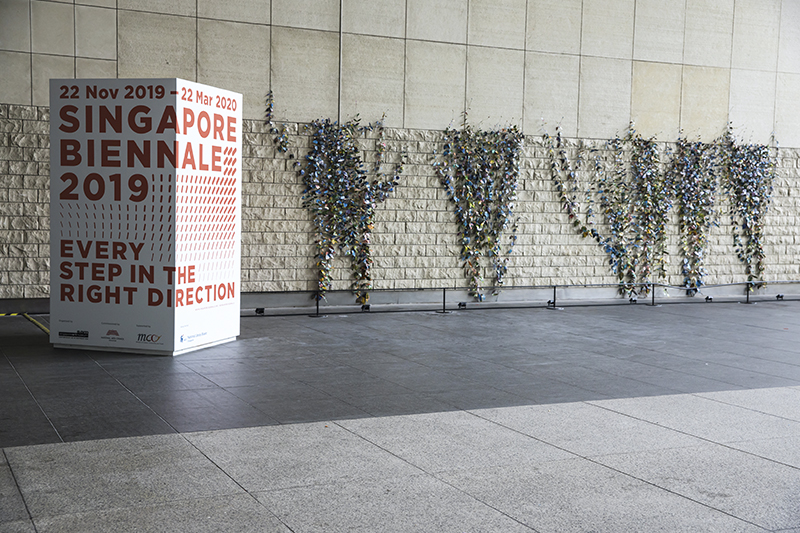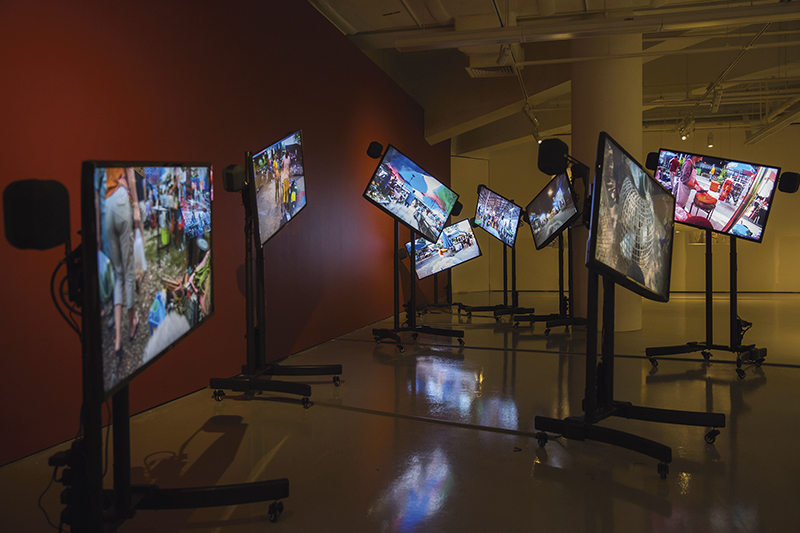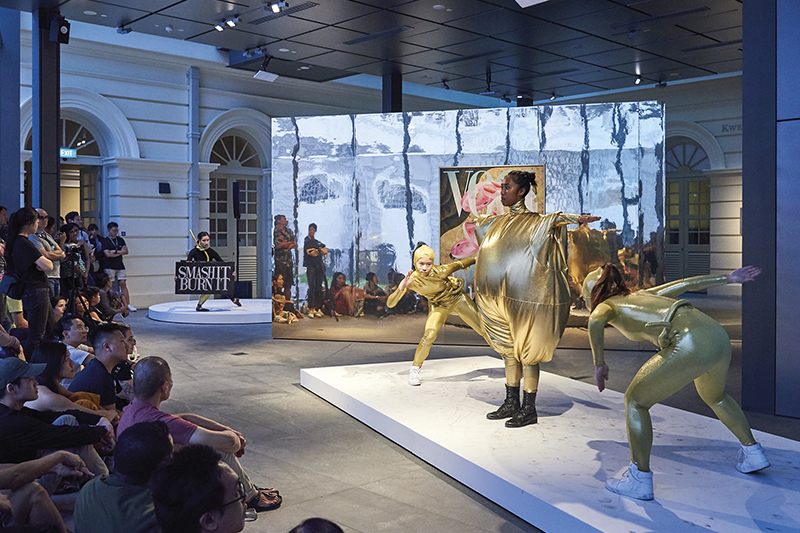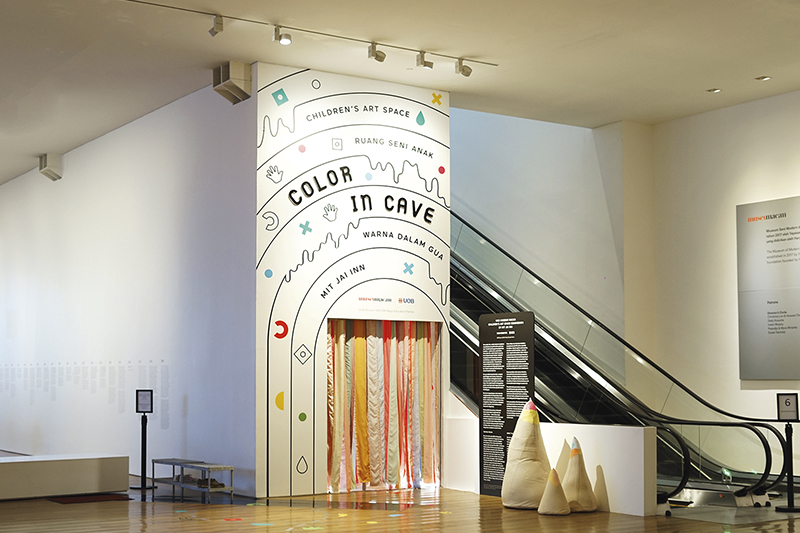
Thailand But Not As We Know It
Contemporary Thai artists are unveiling startling new visions of their country – drawing admiring glances from a global audience.
Words: Richard Augustin
Photos: Courtesy of the Artists, Singapore Art Museum, Museum MACAN
When the curtain was raised at the sixth edition of the Singapore Biennale in November last year, it signalled an important milestone for the contemporary art movement in neighbouring Thailand. The ongoing Biennale runs until March 22 and features as many as 77 artists and art collectives from Southeast Asia and around the world, with Thai artists featuring prominently and proudly.
The Singapore Biennale is among the largest art exhibitions in the region, and the strong presence of Thai artists in this year’s showcase is proof that contemporary art in the Kingdom is indeed thriving. “In a country that lacks art museums, I think the Biennale boom in 2018 marked a significant turn in the history of art in Thailand,” explains Vipash Purichanont, curator of the Biennale.
“In the last two years we had the Bangkok Art Biennale, Bangkok Biennale and the Thailand Biennale. Artists from different parts of the country also had the chance to show their work in several new international exhibitions. These platforms gave Thai artists the chance to exchange ideas and interact with artists from other countries, as well as to showcase their works to local and international audiences,” he adds.
However, contemporary art, or experimental works created since the second half of the 20th century, is still taking baby steps in Thailand. So despite the growing interest, says Vipash, the new biennales may not necessarily be a leap towards maturity. For that to happen will require a degree of perseverance. “I hope that every new international exhibition from 2018 survives to its second edition in 2020. We need to see how it unfolds. Given that Singapore Biennale 2019 is in its sixth edition, we were relatively quite late to the game.”

A SHOWCASE OF IDEAS
But as the saying goes, better late than never, and for that reason alone, it bodes well for the Thai art community that several of its leading figures have work on show at this year’s Singapore Biennale. Thai artists Ruangsak Anuwatwimon, Arnont Nongyao and Paphonsak La-or are seasoned veterans who are lending their vision and creativity to this year’s theme of “Every Step in the Right Direction”, challenging viewers to think about the future – economically, ecologically and aesthetically.
“I was both curious and excited about being given an opportunity to participate in this exhibition,” Ruangsak enthuses. The Bangkok-based artist draws inspiration from nature and presents these elements again in Singapore with his piece titled “Reincarnations”, in which he examines species that are now extinct or endangered due to the destruction of their habitat.
Ruangsak believes art is a great platform to raise issues of concern, citing the recent Australian bushfires and the haze that plagues Southeast Asia every year. “It is my hope that ‘Reincarnations’ will help show how fragile nature is and how important it is for the world to get off its path of destruction.”

SOUND & POLITICS
Arnont, however, takes an entirely new approach with his audio-visual installation. The “Opera of Kard (Market)” is an immersive multi-screen installation with 12 channels that play back sounds and scenes from local markets in northern Thailand.
“With the ‘Opera of Kard’, I wanted to convey the feeling that I have when I visit my favourite flea market back home,” says the Chiang Mai-based artist. “I wanted to project that unique soundscape, with the sounds of people, animals and cooking seemingly coming together like the music in an opera.”
In order to bring the artwork together, he and his assistant travelled around for three weeks, recording sounds and visuals in 12 markets around northern Thailand.
Though he often adopts more traditional styles of representation, the artist maintains that he doesn’t separate art forms. “I still enjoy painting and sculpture, but I feel sounds and vibrations are the first elements we are exposed to as humans. Even before we are born, we are already listening to our mother’s heartbeat and sounds from outside her body.”
In the case of Paphonsak, his works often engage with ongoing social and political conflicts, and have been displayed at international expos like the Asia-Pacific Triennial of Contemporary Art (Brisbane, 2015) and at Palais de Tokyo (France, 2006). At the Singapore Biennale, the Nonthaburi-born artist is showing “Far From Home”, a piece inspired by “Kraibaan”, a journal written by King Rama V in 1907.
Fascinated by the photographs of European landscapes captured by the monarch, he created 121 landscapes based on photographs of countries where many Thai and other Southeast Asian political refugees reside. Though his work has been called controversial, Paphonsak believes that the art community has grown more receptive to this theme.
“I have seen and acknowledged the movement of communities in the art world in this region towards this,” he explains. “Initially, the push to address sharp political and social matters in art was seen as both difficult and risky, but eventually we began seeing more galleries, art institutions and festivals as well as artists becoming more open-minded towards this genre.”

MAKING WAVES ACROSS THE REGION
The Singapore Biennale is not the only place where Thai art is making a splash. In Indonesia, Chiang Mai-based artist Mit Jai Inn was recently commissioned by Museum MACAN in Jakarta to design their Children’s Space. For this task, Mit produced “Colour in Cave”, a vibrant, expressive space that comes alive with interaction.
Colour in Cave is on display at MACAN (Modern and Contemporary Art in Nusantara) museum in Jakarta until March and the artist hopes the space will help inspire young creative minds to explore and flourish in a stimulating environment. “It’s a real honour for me to see this project through as it is about children,” explains Mit Jai Inn.
A seminal figure in the Thai contemporary art scene, Mit co-founded the Chiang Mai Social Installation Project in the early ‘90s and the Cartel Art Space in Bangkok in 2013. He explains that the Chiang Mai project was created to show how the practice of art can be inseparable from our daily lives and vice versa.
Similarly, the Cartel Art Space serves as an avenue for local artists to express themselves without fear of censorship. “They [the artists] have no pressure within this space, so they do not have to worry about what is right or wrong, what is art, or if they can sell or not,” he says. “Because ultimately, we need young artists like we need clean water.”
Vipash agrees, saying Thai artists are playing a major role in shaping contemporary art in the region. However, he wonders whether the category of Thai contemporary art should even exist in the first place.
“What kind of artistic practice is perceived by the art world as Thai art?” he asks.
“I think at this point in time, it is more important to highlight how Thai artists engage with shared contemporary issues,” he adds. “Those [issues] go beyond national boundaries. I think in order to be accepted by the international art community, we need to speak the same language of contemporary art – one that is universal and appreciated by all.”

ศิลปินรวม 77 คนจากเอเชียตะวันออกเฉียงใต้ ได้โอกาสอวดผลงานของตัวเองในสิงคโปร์เบียนนาเล่ ครั้งที่ 6 ซึ่งจัดขึ้นเมื่อเดือนพฤศจิกายนปีที่แล้วจนถึงวันที่ 22 มีนาคมปีนี้ ศิลปินส่วนใหญ่มาจากประเทศไทย ตามความเห็นของวิภาช ภูริชานนท์ ภัณฑารักษ์ของเทศกาลมองว่า ความสำเร็จของศิลปินไทยในการแสดงงานในเทศกาลศิลปะครั้งนี้มีจุดเริ่มต้นจากความสำเร็จของเทศกาลศิลปะในประเทศไทยเมื่อปี 2561
บางกอกอาร์ตเบียนนาเล่ บางกอกเบียนนาเล่และไทยแลนด์เบียนนาเล่ที่จัดขึ้นเมื่อสองปีที่ผ่านมา ทำให้ศิลปินจากทั่วประเทศไทยมีเวทีแสดงงานศิลปะให้ผู้คนทั้งในและต่างชาติได้ประจักษ์ แต่ผู้ร่วมก่อตั้ง Waiting You Curator Lab กล่าวว่า แค่การเริ่มต้นที่ดีอาจไม่เพียงพอให้เกิดการเปลี่ยนแปลงของประวัติศาสตร์ศิลปะในไทย เราได้แต่หวังว่าคลื่นความสนใจในงานศิลปะจะกระเพื่อมต่อไปจนทำให้ไทยแลนด์เบียนนาเล่ครั้งที่ 2 ที่จะจัดขึ้นในปี 2563 ประสบความสำเร็จเหมือนกับสิงคโปร์เบียนนาเล่ที่จัดขึ้นครั้งนี้เป็นครั้งที่ 6 แล้ว
ในเทศกาลครั้งนี้ เรืองศักดิ์ อนุวัตรวิมล อานนท์ นงค์เยาว์ และปพนธ์ศักดิ์ ละออ คือสามศิลปินไทยผู้แสดงผลงานภายใต้หัวข้อ “Every Step in the Right Direction”
เรืองศักดิ์ ศิลปินจากกรุงเทพฯ ใช้แรงบันดาลใจจากธรรมชาติ สร้างผลงานชื่อ “Reincarnations” เพื่อสื่อถึงสิ่งมีชีวิตที่สูญพันธุ์เนื่องจากสูญเสียที่อยู่ตามธรรมชาติไป คุณเรืองศักดิ์อยากใช้เวทีแห่งนี้แสดงให้ทุกคนเห็นว่าธรรมชาติเปราะบางมากแค่ไหน และถึงเวลาที่เราทุกคนจะออกจากเส้นทางแห่งการทำลายล้างนี้เสียที
งานศิลปะชื่อ ‘Opera of Kard’ โดยอานนท์ ศิลปินจากเชียงใหม่ ไม่ได้สื่อผ่านภาพวาดหรือรูปปั้นดังเคย แต่กลับสะท้อนความคิดบนหน้าจอพร้อมกับเสียงใน ‘กาด’ หรือตลาดทางภาคเหนือของไทย เสียงเซ็งแซ่ของผู้คน เสียงสัตว์ เสียงทำอาหาร ในตลาดสอดประสานกันอย่างลงตัวประหนึ่งโอเปร่าอันไพเราะ
งานศิลปะส่วนใหญ่ของปพนธ์ศักดิ์ มักจะเกี่ยวเนื่องกับความขัดแย้งทางสังคมและการเมือง งานแสดงศิลปะครั้งนี้ก็เช่นกัน ได้รับแรงบันดาลใจจากพระราชนิพนธ์ “ไกลบ้าน” จนเกิดเป็น ‘Far From Home’ ที่แสดงภาพวาดภูมิทัศน์ทวีปยุโรปกว่า 121 ภาพ สถานที่เหล่านี้เป็นที่พักอาศัยของชาวไทยและชาวเอเชียตะวันออกเฉียงใต้ที่ต้องอาศัยนอกบ้านเกิดเนื่องจากเหตุผลทางการเมือง ปพนธ์ศักดิ์ ผู้มีถิ่นกำเนิดที่จังหวัดนนทบุรี กล่าวว่า การชูประเด็นด้านสังคมและการเมืองผ่านงานศิลปะเป็นเรื่องค่อนข้างสุ่มเสี่ยง แต่โลกแห่งศิลปะในภูมิภาคนี้ก็เริ่มเปิดรับแนวทางศิลปะที่สื่อถึงประเด็นเหล่านี้มากขึ้นกว่าเดิม
ไม่ใช่แค่สิงคโปร์เบียนนาเล่เท่านั้น แต่ศิลปินไทยจากเชียงใหม่อย่าง มิตร ใจอินทร์ก็ได้รับโอกาสจากพิพิธภัณฑ์ MACAN กรุงจาการ์ต้า ประเทศอินโดนีเซีย ให้ออกแบบ ‘Colour in Cave’ ซึ่งเป็นพื้นที่สีสันสดใสสำหรับเด็ก พื้นที่ศิลปะแบบอินเตอร์แอคทีฟนี้จัดแสดงถึงเดือนมีนาคมนี้ โดยเจ้าของผลงานหวังว่าพื้นที่แห่งนี้จะสร้างแรงบันดาลใจให้ศิลปะ สามารถบ่มเพาะและเบ่งบานในใจทุกคนโดยไม่จำกัดอายุ
ในช่วงปี 2530 คุณมิตรได้ร่วมก่อตั้ง Chiang Mai Social Installation Project และ Cartel Art Space ที่กรุงเทพฯ ในปี 2556 เพื่อชี้ให้เห็นว่า ชีวิตประจำวันและศิลปะเป็นสิ่งที่แยกออกจากกันไม่ได้ ศิลปินจะได้มีโอกาสสร้างและแสดงงานศิลปะของตนเองโดยไม่ต้องกังวลว่าถูกหรือผิด โดยไม่ต้องกังวลว่าจะขายงานได้หรือไม่ เพราะสุดท้ายแล้วเราก็ต้องการศิลปินหน้าใหม่ๆ เหมือนกับที่ชีวิตของเราขาดน้ำไม่ได้
วิภาช เห็นด้วยกับแนวคิดนี้ เขากล่าวว่า ถึงเวลาแล้วที่ศิลปินไทยต้องร่วมสร้างผลงานศิลปะร่วมสมัยโดยไม่ยึดติดกับเชื้อชาติและพรมแดน เราจำเป็นต้องสื่อสารเป็นภาษาเดียวกับงานศิลปะร่วมสมัยเพื่อให้ได้รับการยอมรับในสังคมศิลปะนานาชาติ และสร้างงานที่ทุกคนสามารถชื่นชมได้อย่างเป็นสากล
